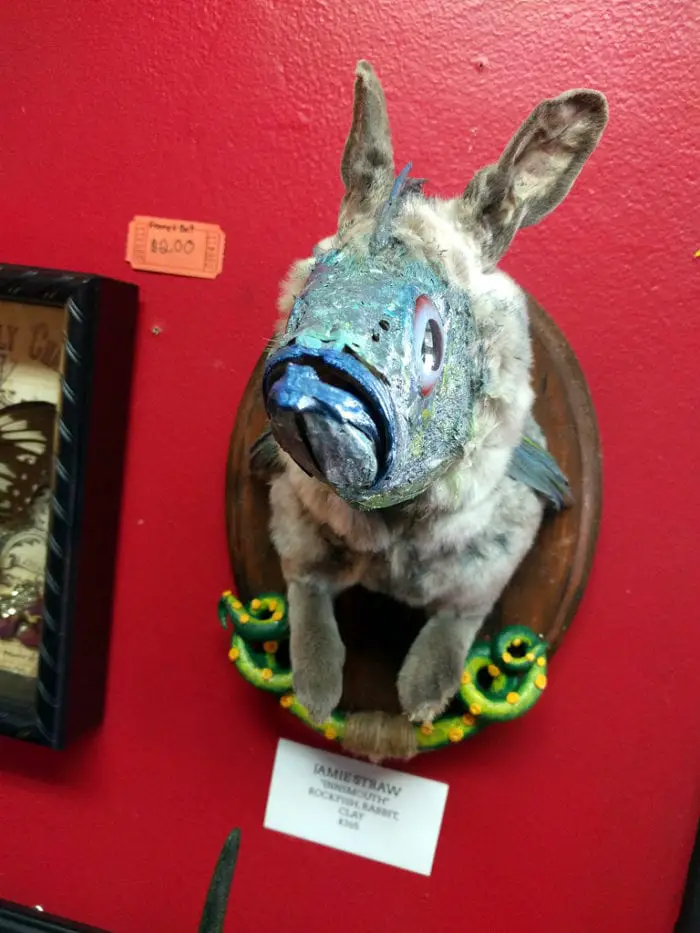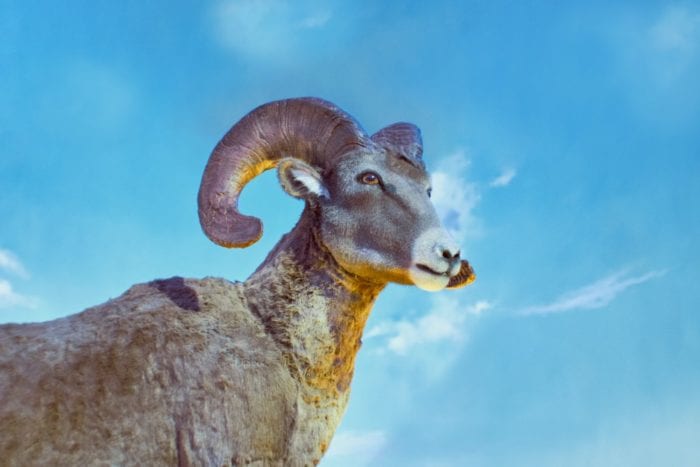Stuffed animals have been a childhood favorite adored by many youngsters since the late 19th century in Germany and early 20th century in the United States. They are a loveable addition to any child’s collection of toys. Stuffed animals can be a wonderful pastime for adults as well, particularly the process it takes to stuff and mount them in various places.
Taxidermy is the official name for that particular hobby, though, and in more academic terms, it refers to the preservation of an animal’s body for display purposes. Stuffed animals with spooky eyes that follow you when you’re at the natural history museum. That’s taxidermy. A stuffed goat falcon fish hybrid, that’s taxidermy too. However, the latter is arguably more interesting than your favorite polar bear at the natural history museum.

The goat falcon fish, better known as “Capricorn” by Sarina Brewer, is an example of a subset of taxidermy that falls under many names. Some call it hybrid taxidermy, chimera taxidermy, rogue taxidermy, or anthropomorphic taxidermy. They are all different names for the same basic thing: sewing different animal parts together to create a grotesque masterpiece. Hybrid taxidermy is as it sounds, the use of taxidermy as an art form that creates hybrid creatures like the aforementioned Capricorn.
History of Hybrid Taxidermy
The mixture of animals has been a common theme in mythologies across the globe for a very long time, from the famous griffin to not-so-famous examples like the hippalectryon, the horse rooster from Greek mythology. Given this, it may not be so shocking that someone arrived at the conclusion that bringing these creations to pseudo-life was a good idea. What is known as hybrid taxidermy today, however, should not be confused with what it came from. Ordinary taxidermy, while in some cases a disturbing sight, can’t be confused with the post-mortem fusion of different animals that is hybrid taxidermy. Hybrid taxidermy is an art form and a science. Despite the similarities with ordinary taxidermy, the reason for its creation has evolved through the centuries since its inception.

Hybrid taxidermy has had a strange history, as one might assume, but it did not begin as the avant-garde art form that it is considered today. It began when P.T. Barnum decided to pass off a monkey and fish parts sewn together to make his Fiji Mermaid in the 1840s. A lot of people were entertained and frightened, especially the latter, by the possibility of real hybrid life existing in the world. Many of the early hybrid taxidermy attempts were hoaxes and publicity stunts, though. The only one of which was a real animal was the platypus.
The Victorian era birthed many taxidermy oddities. Victorian taxidermists in particular were prone to many mistakes. A rushed job is a botched job, and in doing so they inadvertently made what would look like hybrid taxidermy. Although these creations were made with hasty tactics that often lead to clumsy mixing of species, they would not be considered hybrid taxidermy by today’s definition. However, they are nonetheless unsettling to look at.
The most recent wave of hybrid taxidermy, the kind that is the beginning of its official acknowledgment as an art form, is called rogue taxidermy. What began in 2002 as a meet-up between three taxidermy enthusiasts—Sarina Brewer, Scott Bibus, and Robert Marbury—in Minneapolis turned into a new art form by 2004. The name was coined by Sabrina Brewer and a band of fellow hybrid taxidermists.
Some Famous Hybrid Taxidermists
The IRL world is full of hybrid taxidermists, but there are also many more that have shared their art with the online world. Sabrina Brewer and Kate Clark are notable examples who have garnered attention in the mainstream media for less negative reasons than the unfortunate Enrique Gomez De Molina, who went to jail for buying illegal animal parts from endangered species. As one might assume, collecting rare animal parts is tricky business, to say the least, and comes with its own litany of legal ramifications.
Clark and Brewer’s styles differ, but their love of hybrid taxidermy shows in their body of work. Clark’s style has a specific emphasis on merging a human face with an animal body, as displayed in her art showcase. Brewer’s style reveals that of one more true to a hybrid style of blending non-human animals together for a mystical amalgamation, like this three-headed Turducken.
Vegan Hybrid Taxidermy
For some rogue taxidermists, the idea of using animal products is just not moral. There are many hybrid taxidermists who prefer to use vegan options when constructing their menageries, such as faux fur, realistic plastic pieces, etc. These creations can be just as unsettling as the real thing.
Vegan taxidermists utilize papier-mâché, cloth, 3-D printing, and many other materials to craft their oddities. There are many options to recreate a life-like animal. This is especially the case of Sarina Featherstone, who uses a combination of polymer plastic, resin, and 3-D printing with some added acrylic paint to make some of her hybrid skull creations. The 3-D printing does the job of portraying life-like bones and skull structure.
Hybrid Taxidermy Shops
Yes, you can buy a hybrid taxidermied creation of your very own, but it can be pricey. Not to say it’s not worth the price—far from it. Many of these pieces are made with great care and talent, which should not go unnoticed. These works are delightfully creepy, are a perfect set-piece, and definitely a conversation starter. If hybrid taxidermy tickles your fancy, here are some hybrid taxidermists on Etsy with a knack for creating both vegan and non-vegan hybrid taxidermy art pieces.

Hybrid taxidermy’s evolution through the years brings many truths to light, especially the fascination with the macabre and grotesque. From P T Barnum’s Fiji Mermaid to the Capricorn, there is definitely something to say about what can be seen as tastefully strange. The fascination with blending species continues to stand despite how terrifying it may look. Hybrid taxidermy, put simply, brings dark fantasy to life.


